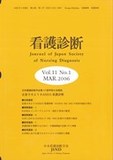Japanese
English
- 有料閲覧
- Abstract 文献概要
- 参考文献 Reference
本研究は,神経系に障害をもつ患者の入院時の看護診断における臨床看護師の仮説検証過程を分析し,検証の根拠となる診断指標と関連因子の用いられ方の特徴を明らかにすることを目的とした.看護師22名を対象に入院時の看護歴聴取場面に同席し,30名の患者に対する看護診断過程について半構成的面接を行い,逐語録から以下を分析した.①診断上の仮説と仮説検証にあたる文脈を抽出し,仮説検証のパターンを分類,②確定された診断名のうち6つを選びNANDAの診断指標,関連因子と照合,③確定されなかった仮説の検証過程の特徴.この結果,115件の仮説が立てられ,仮説検証過程については確定,棄却,保留,中断の特徴が見いだせた.確定された6つの診断名のうち,NANDAの診断指標,関連因子と一致がみられた診断名は【不安】,【急性疼痛】,【入浴/清潔セルフケア不足】,【感覚知覚混乱】であった.一部に不一致がみられた診断名は【身体可動性障害】,【歩行障害】であった.【身体可動性障害】で看護師がとらえた診断指標は,食事動作などのセルフケア行動であり,NANDAの指標とは異なった.【歩行障害】では,「ふらつく」という独自の診断指標が用いられていた.棄却,保留,中断された仮説の検証過程においては,診断指標や関連因子の確認不足によって潜在する問題の見逃しや誤診のおそれのあることが明らかになった.これより,診断指標および関連因子の開発と検討を進めるとともに,適切な診断がされるように看護師の学習を支援していく必要性が示唆された.
The present study was undertaken to analyze the processes of testing the validity of hypotheses conducted by clinical nurses about the nursing diagnosis made upon hospitalization of patients with neurological disorders and to characterize the methods by which the defining characteristics and related factors were handled in the hypothesis testing procedure. The examiner attended the mi-constructive interview of 30 patients conducted by 22 nurses upon admission to take the disease history of these patients. The records of these interviews were processed and analyzed as follows: (1) sentences related to the diagnostic hypothesis and its testing were extracted for classification of the hypothesis-testing patterns; (2) six established diagnosis were selected and compared with the NANDA's defining characteristics and related factors; and (3) characteristics of the hypothesis-testing procedure for non-established diagnoses were analyzed. 115 hypotheses were created and they were established, rejected, rated as pending or cancelled during the hypothesis-testing procedure. Of the 6 established diagnosis, four (“anxiety”,“acute pain”, “bathing/hygiene self-care deficit”and“disturbed sensory perception”) were identical to the NANDA's defining characteristics and related factors. “Impaired physical mobility”and“impaired walking”were partially discrepant from the NANDA's defining characteristics or related factors. Nurses made a diagnosis of “impaired physical mobility”on the basis of self-care behaviors such as eating behaviors, unlike the indicators used by NANDA for defining this diagnosis. A diagnosis of“impaired walking”was made on the basis of instability during walking (an indicator not used by NANDA). The study revealed that during the hypothesis-testing procedure (rejection, pending or cancellation), overlooking of latent problems or misdiagnosis can be caused by inadequate checks of defining characteristics or related factors. The results suggest the necessity of reviewing and developing the defining characteristics and related factors used for nursing diagnosis and to provide support to nurses when they learn how to make appropriate diagnosis.
Copyright © 2006, Japan Society of Nursing Diagnosis. All rights reserved.


